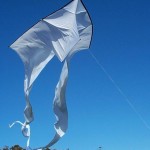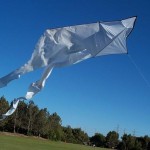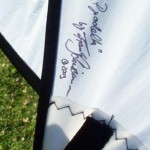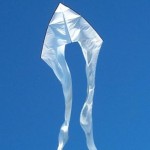 Specifications
Specifications
Manufacturer: Frank Schwiemann
Model: “Ghost” Pyro Delta
Wingspan: 144″ (Twelve feet)
Height: 74″ (Six feet, two inches)
Length: 32 foot tails
Wind Range: 5 – 20 mph
Type of kite: Single Line Delta, with tails.
Materials: Soft Ripstop fabric, with Fiberglass Frame.
Source for test kite: Store bought, new.
The Pyro Delta designed by Frank Schweimann is a finely crafted kite that can be flown in a wide wind range with very little experience required. The Pyro is as unique as the designer himself. It is not hard to figure out why the Pyro has remained popular since it debuted at Dieppe in 1998.
Quality of Construction
The frame is standard fiberglass as with many other deltas, but the rip stop fabric used in this kite is what is most interesting. It’s soft and light and is the reason the tails have a fluid motion in the lightest of breezes. The fluid motion is the very reason that, after seeing one for the first time, I had to have one.
The kite is extremely well constructed and the passion of Mr. Schweimann is clearly seen in details. Everything from the zig-zag stitches right down to the signature on the keel exudes quality.
The kite only has one tow point on the keel. There are no complicated bridles or adjustments needed before you attach the lines and put it up in the air. Simplicity is the reason why this kite is so beautiful.
When it is new there is some assembly required because it is broken down for ease of shipping. You will need to be comfortable with putting together the spars and sliding them into the leading edge pockets. The two edges are 2 parts each, and the spreader is the longest single rod. There aren’t any assembly instructions, but it really is self-explanatory. I recommend you assemble the Pyro at home first to familiarize yourself with it before going to the field.
Each leading edge has a long rod and a short rod of approximately 12 inches. The short rod can be easy to lose. I initially used to leave it in the pocket and fold it up when I put it away. I now remove it and roll it up with the spreader as I would a stunt kite. I do this because, during assembly at the field, the rod would always slide out before I got to it and slipped it into the ferrule and closed the Velcro over the pocket.
Flight Characteristics
The kite is reported to fly in 5 – 20 mph of wind. Mine has flown in as little as 4 mph. Anything above 15, which is the conditions I had during the photo shoot, the frame really flexes and appears to be under a lot stress. When the wind is this high it has some strong pull. You might consider getting an anchor system of some sort. You should use at least 250 pound line. It’s a little more than needed, but I like the added security.
The Kite comes with a nice zippered nylon bag that will hold the kite with the leading edges partially assembled. There is a knack to getting the 30+ feet of tails and the rest all into the bag neatly. Fortunately Steve at Gone With The Wind Kites showed me the light. It’s very similar to putting away a stunt kite. You take the two leading edges and put them together. Put the spreader and your smaller rods, if you removed them, alongside. Then roll it up. The trick with the tails is to gather them and spin them onto the rods. By this I mean you go back and forth up and down in a similar pattern to a barbershop pole. You should make a couple tight wraps around the end before you come back the other way. Finally you can use the tail ends to tie a loose half hitch, which holds everything in place until you are ready to go flying again.
If we were trying to find faults with the kite, I suppose I could mention that the ferrule is not glued and can move inside the edge pocket. Also, the nylon loop at the tow point where you attach your line could be beefed up just a touch. I can see it wearing through very quickly. You might consider a carabineer or attach a loop of line and tie onto that, as I have.
Flight photos by Andrew McIvor
Summary
Some people have asked me, ‘what possessed me to purchase a kite such as the Pyro?’ My answer is simple. It is the only kite I have ever seen, that can take me back to my childhood, when I flew my first kite at the age of 5. The fluid beauty of the Pyro in the air, gives me that little squirm of fun in the pit of my belly.
On the whole you have to consider whether $400.00, depending on the exchange rate, and whether you’re an AKA member or not, is acceptable when you can buy the licensed copy for $150.00. Fortunately I didn’t have to make that choice. The copies were not available when I made my decision. For me the craftsman quality and elusiveness of a kite made by Frank himself is reason enough for me.









